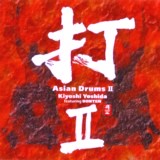|

PMR-0027 |
Asian Drums II /
Kiyoshi Yoshida
featuring BONTEN
01.
A Circle Of Guilt
|
|
Japanese drums known as "wadaiko" are popular abroad as well as in Japan. The overseas performances by the drum band "Onndekoza" and the solo player Eitetsu Hayashi who pioneered in solo drum performance win admiration world-wide. And there are the young people born abroad with a Japanese heritage who form drum bands in the search for their identity. The Japanese rock band "Musashi" which includes wadaiko and shakuhachi (flute) in their gigs are proving popular in Central America and the American West Coast. The band "Hiroshima", put together by second generation Japanese Americans from the LA area, have established a firm hold in the American music field since the 1970's, creating their music based on wadaiko, flute and Western instruments.
In 1999, the synthesizer operator and music producer Kiyoshi Yoshida released a PACIFIC MOON LABEL album featuring the wadaiko called "Asian Drums". It ranked sixteenth on the music chart for the American FM New Age Music genre. The newly released "Asian Drums 2" is the second of the series that was released in the wake of its success. When we say "wadaiko", we the Japanese, usually imagine a lively and energetic scene, high in spirits and with gallantry but, it feels to me like Yoshida has given the drums an entirely different direction in the case of these two albums. He does not make use of the Japanese sense of time-space or "ma", stretching time or making it short, but instead keeps the basic beat as the basis of the music. It's a good way to blend the sounds of the synthesizer and the wadaiko. The wadaiko which is normally put in the forefront is kept in the back and backs up the entire piece. By keeping the wadaiko which can create a world by just a single sound under lids patiently for just a little while, the ever transforming synthesizer which has no characteristic of its own comes to the surface. The role of the wadaiko here is to set a stable moto-tone feel, rather than to rigorously create a beat. The sounds that are the most often heard are shamisen like sounds playing in unison. This is the cheerful and bright part of the piece, these speedy phrases have the role of pulling the music forward more and more. The wadaiko performers in the album belong to the "Bonten" and is led by Masataka Kobayashi.
by Yasuki Matsumoto
|
